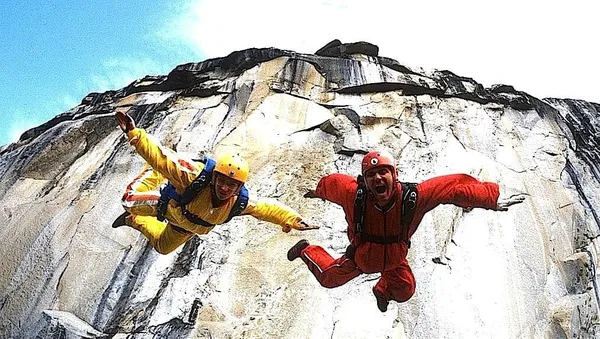 |
| Jean Boenish and BASE jumping pioneer Carl Boenish in Marah Strauch's soaring Sunshine Superman |
A conversation with Marah Strauch on Carl Boenish turned to John Frankenheimer's The Gypsy Moths, starring Deborah Kerr, Burt Lancaster and Gene Hackman, German mountain films by Arnold Fanck with Luis Trenker and Leni Riefenstahl, Werner Herzog's Fitzcarraldo and Les Blank's Burden Of Dreams with a touch of Caspar David Friedrich and a beam of Donovan's Sunshine Superman.
The Sunshine Superman here is Carl Boenish, the founder of BASE jumping. Breathtaking aerial footage shot by Boenish and his colleagues accompanies a glimpse into the development of the extreme sport, always close to the edge, head in the clouds. It is a film filled with light and air with a refreshing lack of cynicism. Director Strauch in interviews with Boenish's wife Jean explores how the private man, the scholar of Christian Science and the pusher of boundaries influenced his environment.
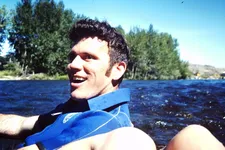 |
| Carl Boenish in Sunshine Superman: "He recorded these things he called 'Living Letters'." |
Anne-Katrin Titze: I was very surprised by your film. It was not at all what I expected. I found it majestic on the one hand and also life-affirming. Do you jump? Do you do BASE jumping?
Marah Strauch: I'm not a BASE jumper but I grew up with a dad who was a pioneer rock climber and an uncle who was a BASE jumper. So I grew up rock climbing and kind of doing more adventurous activities and having it be a part of my every day normal life. I've been skydiving a couple of times but I am not a BASE jumper.
AKT: Why did you decide to tell the story of Carl Boenish, who is recognised as the inventor of BASE jumping?
MS: I discovered the films through my uncle because he was a BASE jumper and aerial cinematographer. He died in an automobile accident and I found all of his footage - my uncle's, and also some of Carl Boenish's footage within this footage. And I eventually found Jean Boenish. I saw Carl's films and, as a filmmaker, I really responded to the beauty and majestic-ness of this footage. And I really wanted to find out more, I think, because I'm not a BASE jumper, partially. I was curious as to why this man invented this thing. To me, it was a natural progression after finding Carl's footage.
AKT: You show how he did some of the shots. That construct with a ladder and a bicycle seat at the end - it is terrifying just watching him on there. The fragility of it all.
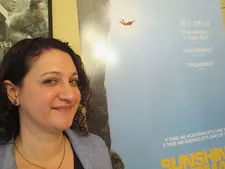 |
| Sunshine Superman director Marah Strauch on Herzog's Rogue Film School: "Werner says that he likes to teach people how to pick locks and forge documents." Photo: Anne-Katrin Titze |
MS: What I responded to also was that they had these giant cameras that they put on their heads. Carl built this amazing ladder, he put it off the side of a cliff and then walks out on this ladder - to me it's the most physical filmmaking you can do. I responded to the physicality in shooting, this way of making films almost with your whole body. I loved that.
AKT: He started out in John Frankenheimer's The Gypsy Moths. Was that how he began filming?
MS: He shot a lot before that, experiments, because not a lot of people were doing aerial cinematography. He was very much pioneering aerial cinematography as well. Eventually he was put in charge of filming the aerial cinematography for John Frankenheimer's film The Gypsy Moths.
AKT: Did Burt Lancaster, Gene Hackman, or Deborah Kerr ever jump? Do you know anything about the shoot?
MS: It was all stunt doubles. There's a lot of great cheesy stuff on the set where they look like they're kind of falling. The aerial footage is still absolutely phenomenal. Really amazingly choreographed skydiving, it's very beautiful.
AKT: I read that you attended Werner Herzog's Rogue Film School. What did you do there with Werner Herzog?
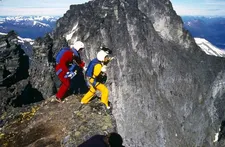 |
| Carl Boenish leaping with Jean Boenish: "Death is ever-present, whether we're BASE jumping or just living." |
MS: It's a wonderful program that Werner Herzog has started. He has a number of students that come together and he talks a lot about filmmaking. I didn't go to film school. This program taught me a lot about filmmaking. Werner says that he likes to teach people how to pick locks and forge documents. I think what he really means is that as a filmmaker you need to think of ways around roadblocks because there will be a lot of them. He has a four day workshop that he gives. He talks to you about your projects. He talked to me about this project very early on.
AKT: Are you working on a new project now?
MS: I'm starting to look into doing some fiction. I'd like to shoot again in Scandinavia. I'm looking into a Scandinavian fiction project. I love landscapes.
AKT: The Norwegian midnight sun got to you. Did you ever watch those early German mountain films by Arnold Fanck with Luis Trenker and Leni Riefenstahl?
MS: Yes, I absolutely did. I also watched Werner Herzog's films. He also has a lot of mountains. I also grew up in Oregon. Landscape and a sense of nature - I grew up rock climbing - all those things resonate with me.
AKT: You should watch a new Western that opened last week, called Slow West, and watch out if anybody reminds you of Herzog [see John Maclean on this impersonation].
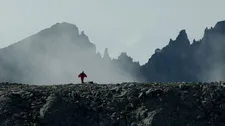 |
| A Caspar David Friedrich moment in Sunshine Superman |
MS: I'm such a fan. Actually, it's funny, my favorite Werner Herzog film is not one that he directed. I love Burden Of Dreams, which is a documentary made by Les Blank, who passed away about a year and a half ago. It's such a phenomenal film about the making of Fitzcarraldo. Again, it's physical filmmaking.
AKT: Speaking of overcoming obstacles…
MS: Exactly.
AKT: To produce the majestic, I believe you used Wagner, Tristan and Isolde and Lohengrin. Then it's the lone figure standing on the mountain - that's very Caspar David Friedrich.
MS (laughing): Yes. You got all my references! Nobody ever does. That's so cool. When I was showing my cinematographer [Nicolay Poulsen] some of the images, I definitely was pulling from Romantic paintings, references that to me really felt like this mountain landscape.
AKT: And at the same time they were jumping from buildings in Texas. The acronym puts it all together in BASE. It's also very basic.
MS: Yeah, Building, Antenna, Span, and Earth is the acronym.
AKT: One thing that you do not go into too much depth is that Boenish was a Christian Scientist.
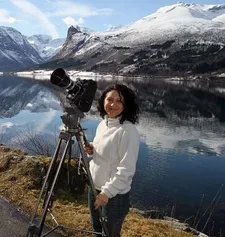 |
| Marah Strauch on the set of Sunshine Superman: "I'm looking into a Scandinavian fiction project. I love landscapes." |
MS: You know, it's interesting, I didn't want it to totally overshadow the rest of the story. He called himself a student of Christian Science. He wasn't a zealot or someone really indoctrinated but it was part of his character and something that he thought very much about. I didn't know anything about Christian Science going into this film. I learned about how a lot of the philosophy is about overcoming artificial limitations in a very spiritual sense. So it makes sense in a physical sense. To put the two together I would have never done myself. It's what the actual characters of Carl and Jean did - that's part of their character.
AKT: Jean talks about "the law of the Universe" at the beginning and the end of your film.
MS: Actually, Carl talks about it. Carl left a lot of audio recordings which was really valuable to us. He recorded these things he called "Living Letters". As a documentarian, that is the coolest thing.
AKT: You have some great interviews also. The ranger [at Yosemite National Park in California] who says, "you don't have to dislike someone to take away their freedom." He is so nice. Of the films I have seen recently, this is one where people seem to be happiest.
MS: A lot of people have found that actually something they criticise. But it's the truth. It's actually the truth. Carl was incredibly happy. The ranger, Bill Wendt, was incredibly gracious to allow us to do this interview. He had a 30 year career with the Park Service and the fact that he was willing to be a part of the project really showed how much Carl affected people. Even the ranger whose job is to monitor Carl and take away his freedom. Wendt had a lot of respect and love for Carl.
AKT: Still, there is something mysterious. It is about people jumping off things, buildings, rocks, whatever it is. Is it connecting people because of the nearness of death that is always there? People suddenly bond in emergencies when the blockades come down.
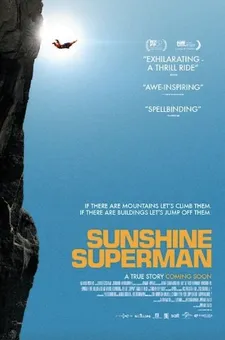 |
| Sunshine Superman US poster |
MS: That's really at the core of the film. Death is ever-present, whether we're BASE jumping or just living. People don't think about it most of the time. For BASE jumpers it's at the forefront of their mind and it creates a very different kind of lifestyle.
AKT: Is Jean still jumping?
MS: She jumped for a number of years after Carl's death. She is flying airplanes, she has a really interesting, rich life. BASE jumping is not something she needs to do at this time.
AKT: There are a few moments in your film that are completely non-cliché and unpredictable. When you hear the line - he says jump and she jumps - you think of horrible connotations, in this case, it isn't. Here they seem to be challenging each other and pushing another person forward.
MS: Absolutely. They were definitely amazing partners in this activity. They really complemented each other, not only pushing each other forward but also the sport of BASE jumping.
AKT: Also, as far as getting back on the horse is concerned, Jean shows remarkable strength in what she thinks she owes to Carl and the sport.
MS: As much as the film is called Sunshine Superman, I think Jean is absolutely the core of the film.
AKT: She is the Sunshine, he is the Superman?
MS: Yeah. They are really parts of the same person in a way.
AKT: You filmed in Trollveggen, the Troll Wall in Norway. Will your next project have that mystical connection?
MS: I don't know exactly. That mountain was incredible. I talked to my Norwegian partners - we did this as a co-production - and they said that mountains in Norway, they are their own people in a way. They have their own presence. I thought about that a lot. When we finally got to the Troll Wall, it was much more menacing and severe than I had ever thought it could be. It was immense and definitely had a presence of its own. It definitely became a character in the film.
Sunshine Superman is currently in theaters in the US and will be screened at the Edinburgh International Film Festival.





















